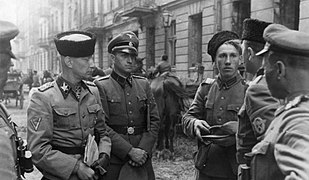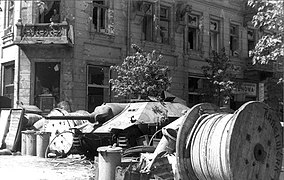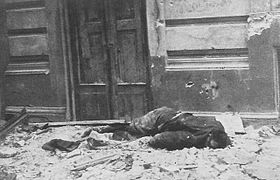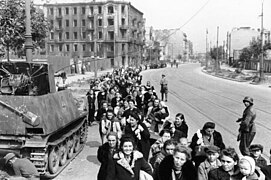
Warsaw Uprising
The Warsaw Uprising (Polish: powstanie warszawskie; German: Warschauer Aufstand), shortly after the war also known as the August Uprising (Polish: powstanie sierpniowe),[15] was a major World War II operation by the Polish underground resistance to liberate Warsaw from German occupation. It occurred in the summer of 1944, and it was led by the Polish resistance Home Army (Polish: Armia Krajowa). The uprising was timed to coincide with the retreat of the German forces from Poland ahead of the Soviet advance.[16] While approaching the eastern suburbs of the city, the Red Army halted combat operations, enabling the Germans to regroup and defeat the Polish resistance and to destroy the city in retaliation. The Uprising was fought for 63 days with little outside support. It was the single largest military effort taken by any European resistance movement during World War II.[17]
For other uses, see Warsaw Uprising (disambiguation).
The Uprising began on 1 August 1944 as part of a nationwide Operation Tempest, launched at the time of the Soviet Lublin–Brest Offensive. The main Polish objectives were to drive the Germans out of Warsaw while helping the Allies defeat Germany. An additional, political goal of the Polish Underground State was to liberate Poland's capital and assert Polish sovereignty before the Soviet-backed Polish Committee of National Liberation could assume control. Other immediate causes included a threat of mass German round-ups of able-bodied Poles for "evacuation"; calls by Radio Moscow's Polish Service for uprising; and an emotional Polish desire for justice and revenge against the enemy after five years of German occupation.[18][19]
Scholarship since the fall of the Soviet Union, combined with eyewitness accounts, has questioned Soviet motives and suggested their lack of support for the Warsaw Uprising represented their ambitions in Eastern Europe. The Red Army did not reinforce resistance fighters or provide air support. Recently declassified documents show Joseph Stalin tactically halted his forces to let the operation fail and allow the Polish resistance to be crushed.[20] Scholars note the two month period of the Warsaw Uprising marked the start of the Cold War.[21] According to the historian Alexandra Richie, for instance, the Warsaw Uprising "laid bare the differences between Poland’s desire for a Western style democracy and freedom, and Stalin’s brutal ambitions to Sovietize postwar Central and Eastern Europe."[22]
Casualties during the Warsaw Uprising were catastrophic. Although the exact number of casualties is unknown, it is estimated that about 16,000 members of the Polish resistance were killed and about 6,000 badly wounded. In addition, between 150,000 and 200,000 Polish civilians died, mostly from mass executions. Jews being harboured by Poles were exposed by German house-to-house clearances and mass evictions of entire neighbourhoods. The defeat of the Warsaw Uprising also further decimated urban areas of Poland.[23]
Warsaw Uprising Memorial Day
Efforts by President Lech Kaczyński in 2009 led to recognition of August 1 as a State holiday, Narodowy Dzień Pamięci Powstania Warszawskiego,.[253]
The preamble of the act reads:
In honour of the heroes of the Warsaw Uprising - those who, in defence of the state, fought for the liberation of the capital city with weapons in their hands, strived to recreate the institutions of an independent Polish state, opposed the German occupation and the spectre of Soviet slavery threatening the next generations of Poles[253]
A moment of silence is observed at 5:00 pm to symbolize the sires of August 1, 1944 at 5:00pm that marked the start of the battle as a signal to resistance fighters.[254] Torches get lit in Warsaw's main square amidst rows of national white and red flags while honorary guards at the Tomb of the Unknown Soldier at Piłsudski Square present arms. Varsovians light firecrackers. Past memorials observers have linked arms to form a human kotwica in front of the Royal Castle.[255]
Numerous works have been influenced by and devoted to the Uprising. In literature, they include: Kolumbowie. Rocznik 20 novel by Polish writer Roman Bratny.[256]
In television, they include documentary film The Ramparts of Warsaw 1943–44, produced for the 70th anniversary of the Warsaw Uprising with support from the European Commission. The Warsaw Uprising is often confused with the revolt in the Warsaw Ghetto which took place a year earlier in the spring of 1943. Three young Europeans, Alexandra (France), Maria (Poland) and Roman (Germany) meet in Warsaw to enquire into these events; here they meet witnesses who took part in the Warsaw Uprising or lived in the ghetto. Beneath their white hair we can recognise the men and women who formed the living ramparts of freedom in the face of Nazism. Meanwhile, the Polish World War II TV drama series Time of Honor (Czas honoru; Series 7), which aired in 2014, was entirely devoted to the Warsaw Uprising.
In cinema, they include:










